Hult EMBA Accounting: Deferred Expenses, Revenue, and Accounting Cycle
VerifiedAdded on 2021/04/21
|31
|5043
|43
Homework Assignment
AI Summary
This document presents a comprehensive solution to an accounting assignment from Hult International Business School's EMBA program. The assignment covers fundamental accounting concepts, including deferred expenses and unearned revenue, providing definitions, examples, and journal entries. It explores the sequence of the full accounting cycle, requiring students to list all steps involved. The solution also addresses specific scenarios involving adjusting entries, such as insurance and interest calculations. Furthermore, it delves into shareholder's equity, differentiating between permanent and temporary accounts and explaining contra accounts. A key component is the construction of a standard cash flow statement, detailing the segmentation of cash flows. Finally, the assignment addresses the distinctions between perpetual and periodic inventory accounting systems and touches upon the concept of goodwill. The solutions provide detailed explanations and calculations, making it a valuable resource for students studying accounting principles.
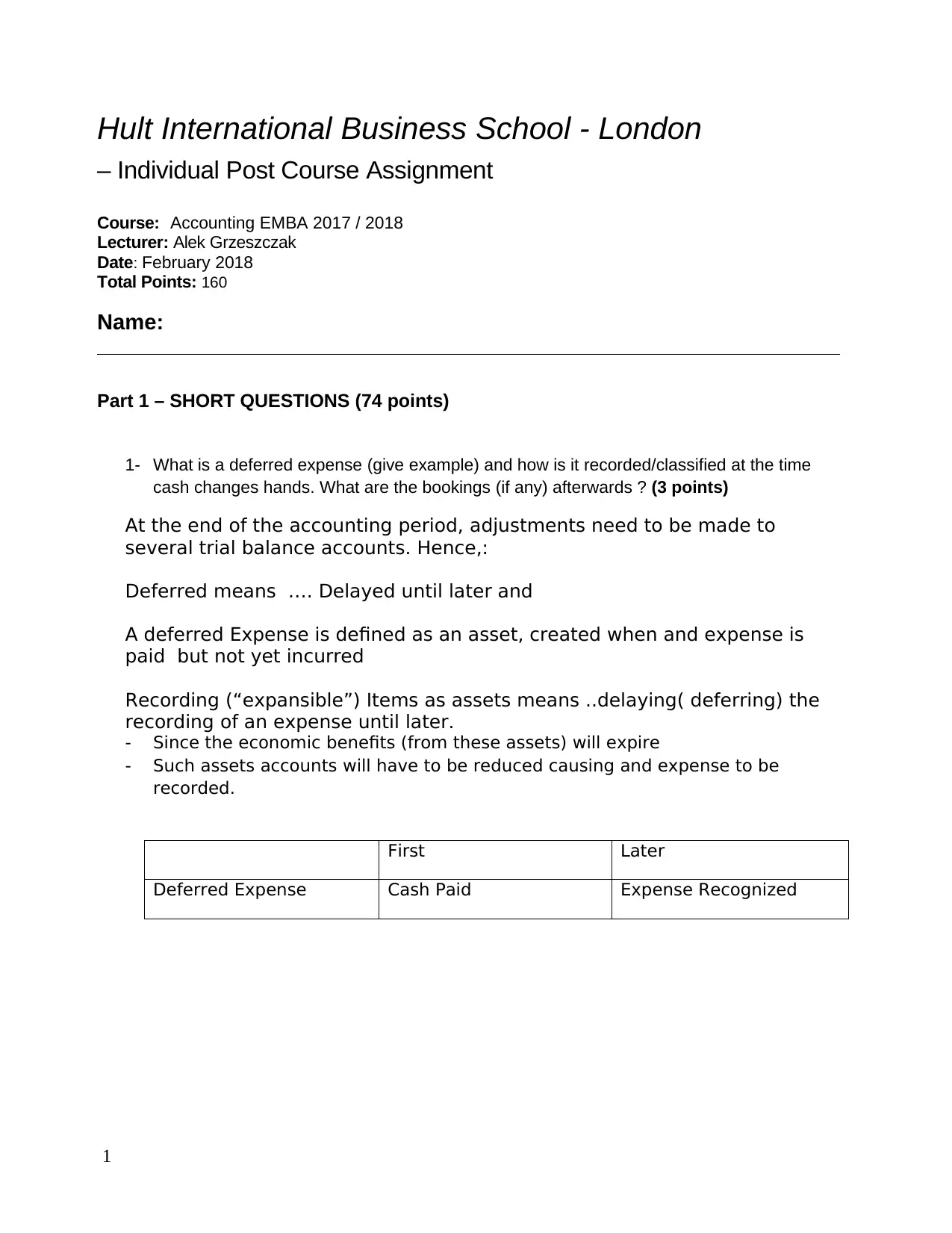
Hult International Business School - London
– Individual Post Course Assignment
Course: Accounting EMBA 2017 / 2018
Lecturer: Alek Grzeszczak
Date: February 2018
Total Points: 160
Name:
Part 1 – SHORT QUESTIONS (74 points)
1- What is a deferred expense (give example) and how is it recorded/classified at the time
cash changes hands. What are the bookings (if any) afterwards ? (3 points)
At the end of the accounting period, adjustments need to be made to
several trial balance accounts. Hence,:
Deferred means …. Delayed until later and
A deferred Expense is defined as an asset, created when and expense is
paid but not yet incurred
Recording (“expansible”) Items as assets means ..delaying( deferring) the
recording of an expense until later.
- Since the economic benefits (from these assets) will expire
- Such assets accounts will have to be reduced causing and expense to be
recorded.
First Later
Deferred Expense Cash Paid Expense Recognized
1
– Individual Post Course Assignment
Course: Accounting EMBA 2017 / 2018
Lecturer: Alek Grzeszczak
Date: February 2018
Total Points: 160
Name:
Part 1 – SHORT QUESTIONS (74 points)
1- What is a deferred expense (give example) and how is it recorded/classified at the time
cash changes hands. What are the bookings (if any) afterwards ? (3 points)
At the end of the accounting period, adjustments need to be made to
several trial balance accounts. Hence,:
Deferred means …. Delayed until later and
A deferred Expense is defined as an asset, created when and expense is
paid but not yet incurred
Recording (“expansible”) Items as assets means ..delaying( deferring) the
recording of an expense until later.
- Since the economic benefits (from these assets) will expire
- Such assets accounts will have to be reduced causing and expense to be
recorded.
First Later
Deferred Expense Cash Paid Expense Recognized
1
Paraphrase This Document
Need a fresh take? Get an instant paraphrase of this document with our AI Paraphraser
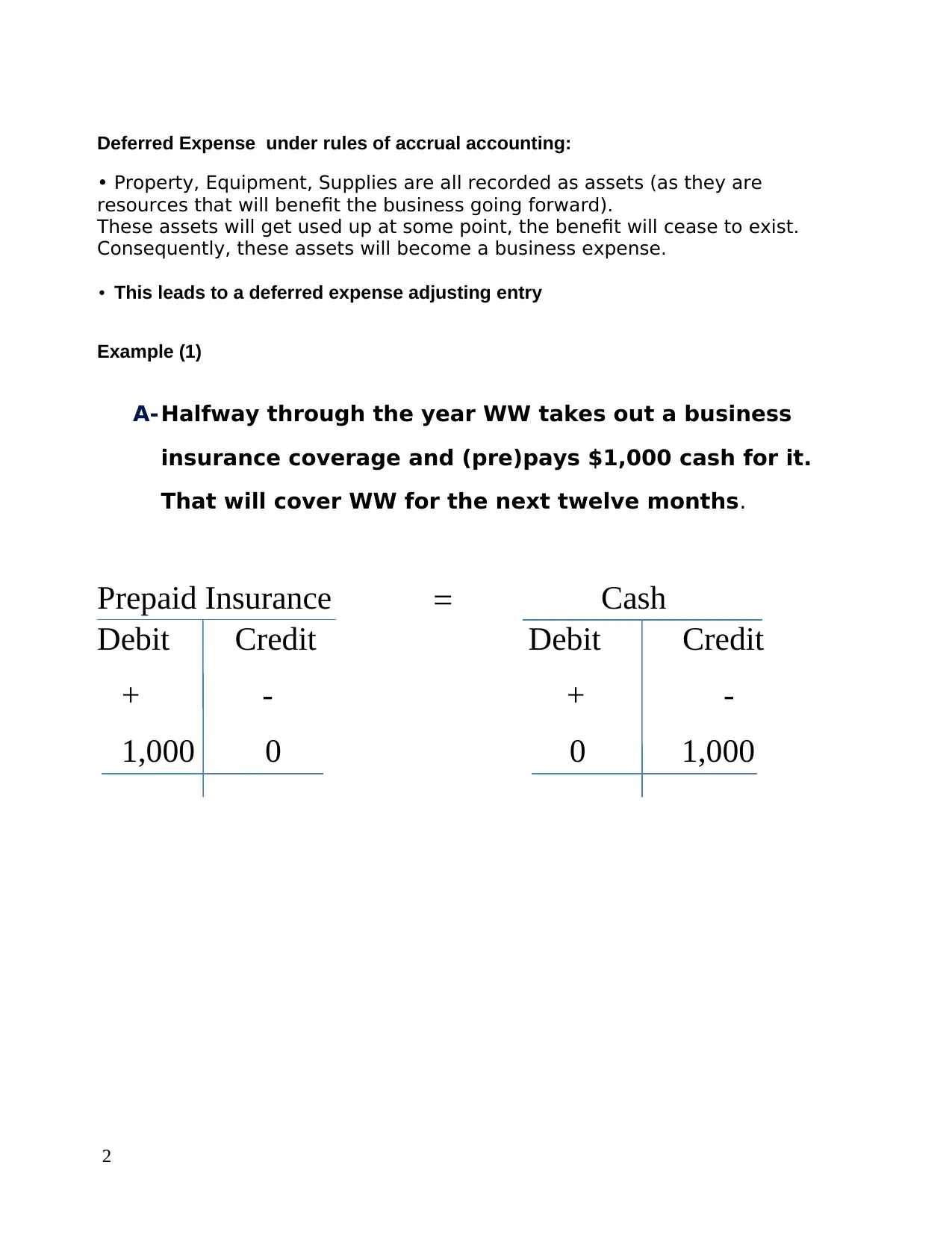
Deferred Expense under rules of accrual accounting:
• Property, Equipment, Supplies are all recorded as assets (as they are
resources that will benefit the business going forward).
These assets will get used up at some point, the benefit will cease to exist.
Consequently, these assets will become a business expense.
• This leads to a deferred expense adjusting entry
Example (1)
A-Halfway through the year WW takes out a business
insurance coverage and (pre)pays $1,000 cash for it.
That will cover WW for the next twelve months.
Prepaid Insurance = Cash
Debit Credit Debit Credit
+ - + -
1,000 0 0 1,000
2
• Property, Equipment, Supplies are all recorded as assets (as they are
resources that will benefit the business going forward).
These assets will get used up at some point, the benefit will cease to exist.
Consequently, these assets will become a business expense.
• This leads to a deferred expense adjusting entry
Example (1)
A-Halfway through the year WW takes out a business
insurance coverage and (pre)pays $1,000 cash for it.
That will cover WW for the next twelve months.
Prepaid Insurance = Cash
Debit Credit Debit Credit
+ - + -
1,000 0 0 1,000
2
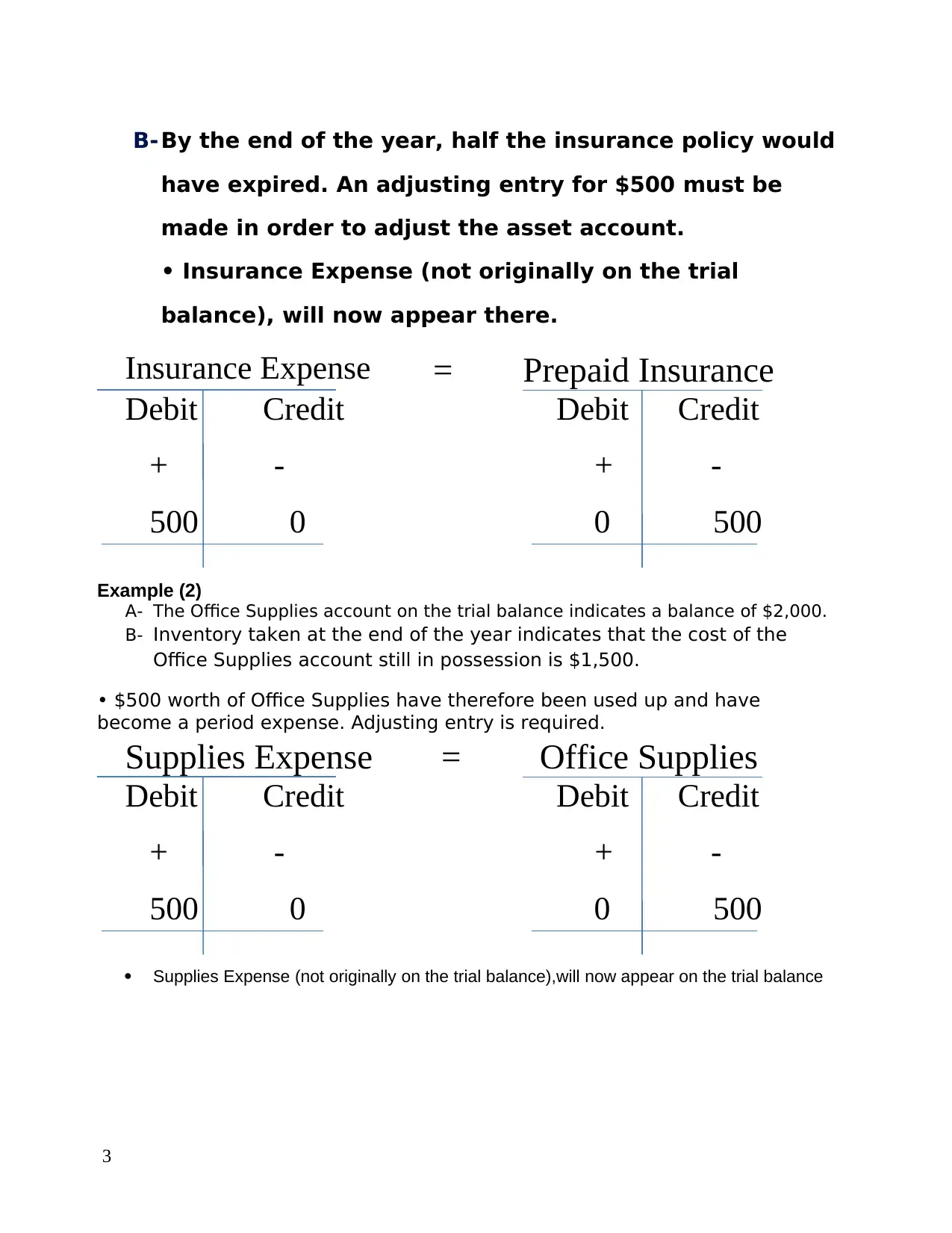
B- By the end of the year, half the insurance policy would
have expired. An adjusting entry for $500 must be
made in order to adjust the asset account.
• Insurance Expense (not originally on the trial
balance), will now appear there.
Insurance Expense = Prepaid Insurance
Debit Credit Debit Credit
+ - + -
500 0 0 500
Example (2)
A- The Office Supplies account on the trial balance indicates a balance of $2,000.
B- Inventory taken at the end of the year indicates that the cost of the
Office Supplies account still in possession is $1,500.
• $500 worth of Office Supplies have therefore been used up and have
become a period expense. Adjusting entry is required.
Supplies Expense = Office Supplies
Debit Credit Debit Credit
+ - + -
500 0 0 500
Supplies Expense (not originally on the trial balance),will now appear on the trial balance
3
have expired. An adjusting entry for $500 must be
made in order to adjust the asset account.
• Insurance Expense (not originally on the trial
balance), will now appear there.
Insurance Expense = Prepaid Insurance
Debit Credit Debit Credit
+ - + -
500 0 0 500
Example (2)
A- The Office Supplies account on the trial balance indicates a balance of $2,000.
B- Inventory taken at the end of the year indicates that the cost of the
Office Supplies account still in possession is $1,500.
• $500 worth of Office Supplies have therefore been used up and have
become a period expense. Adjusting entry is required.
Supplies Expense = Office Supplies
Debit Credit Debit Credit
+ - + -
500 0 0 500
Supplies Expense (not originally on the trial balance),will now appear on the trial balance
3
⊘ This is a preview!⊘
Do you want full access?
Subscribe today to unlock all pages.

Trusted by 1+ million students worldwide
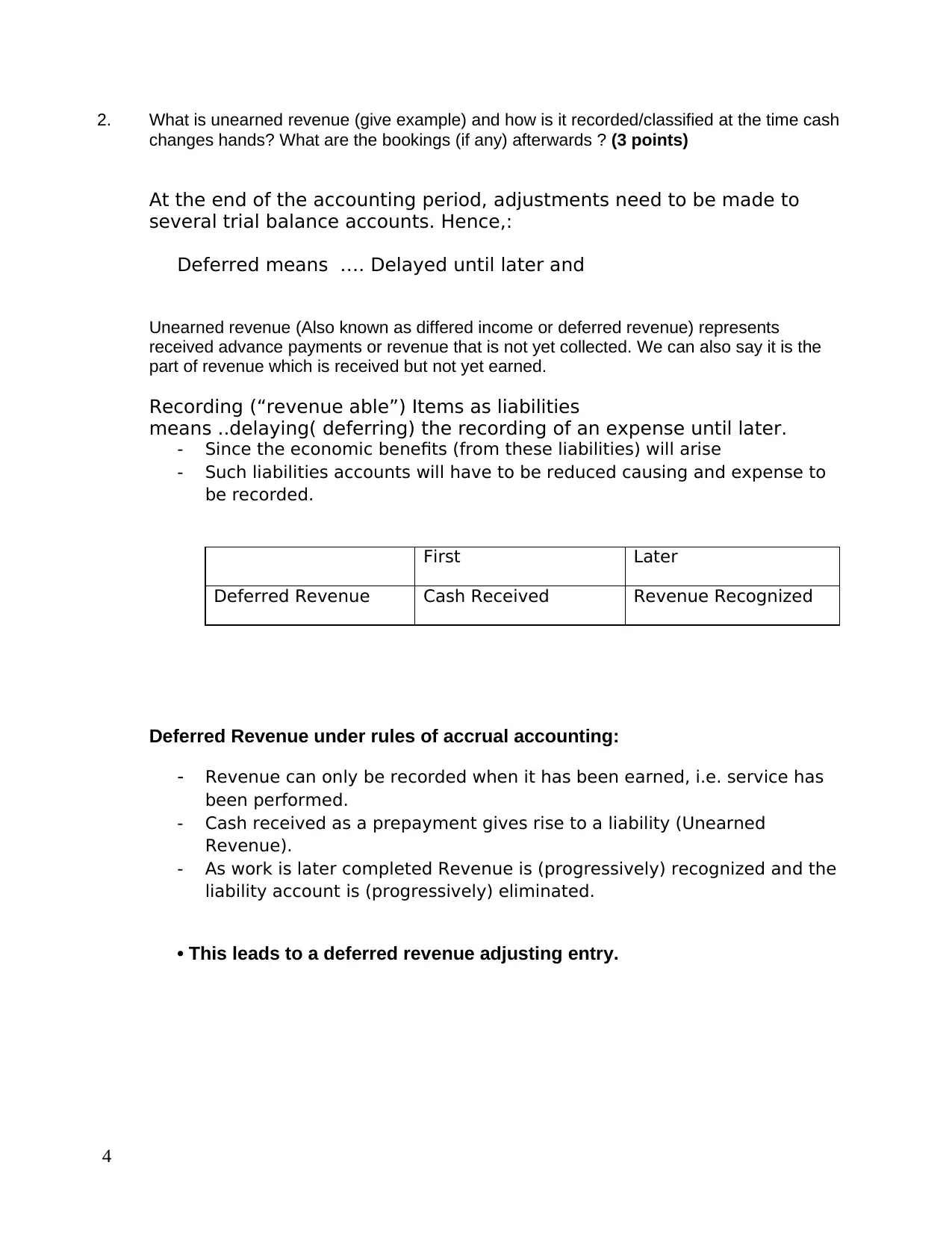
2. What is unearned revenue (give example) and how is it recorded/classified at the time cash
changes hands? What are the bookings (if any) afterwards ? (3 points)
At the end of the accounting period, adjustments need to be made to
several trial balance accounts. Hence,:
Deferred means …. Delayed until later and
Unearned revenue (Also known as differed income or deferred revenue) represents
received advance payments or revenue that is not yet collected. We can also say it is the
part of revenue which is received but not yet earned.
Recording (“revenue able”) Items as liabilities
means ..delaying( deferring) the recording of an expense until later.
- Since the economic benefits (from these liabilities) will arise
- Such liabilities accounts will have to be reduced causing and expense to
be recorded.
First Later
Deferred Revenue Cash Received Revenue Recognized
Deferred Revenue under rules of accrual accounting:
- Revenue can only be recorded when it has been earned, i.e. service has
been performed.
- Cash received as a prepayment gives rise to a liability (Unearned
Revenue).
- As work is later completed Revenue is (progressively) recognized and the
liability account is (progressively) eliminated.
• This leads to a deferred revenue adjusting entry.
4
changes hands? What are the bookings (if any) afterwards ? (3 points)
At the end of the accounting period, adjustments need to be made to
several trial balance accounts. Hence,:
Deferred means …. Delayed until later and
Unearned revenue (Also known as differed income or deferred revenue) represents
received advance payments or revenue that is not yet collected. We can also say it is the
part of revenue which is received but not yet earned.
Recording (“revenue able”) Items as liabilities
means ..delaying( deferring) the recording of an expense until later.
- Since the economic benefits (from these liabilities) will arise
- Such liabilities accounts will have to be reduced causing and expense to
be recorded.
First Later
Deferred Revenue Cash Received Revenue Recognized
Deferred Revenue under rules of accrual accounting:
- Revenue can only be recorded when it has been earned, i.e. service has
been performed.
- Cash received as a prepayment gives rise to a liability (Unearned
Revenue).
- As work is later completed Revenue is (progressively) recognized and the
liability account is (progressively) eliminated.
• This leads to a deferred revenue adjusting entry.
4
Paraphrase This Document
Need a fresh take? Get an instant paraphrase of this document with our AI Paraphraser
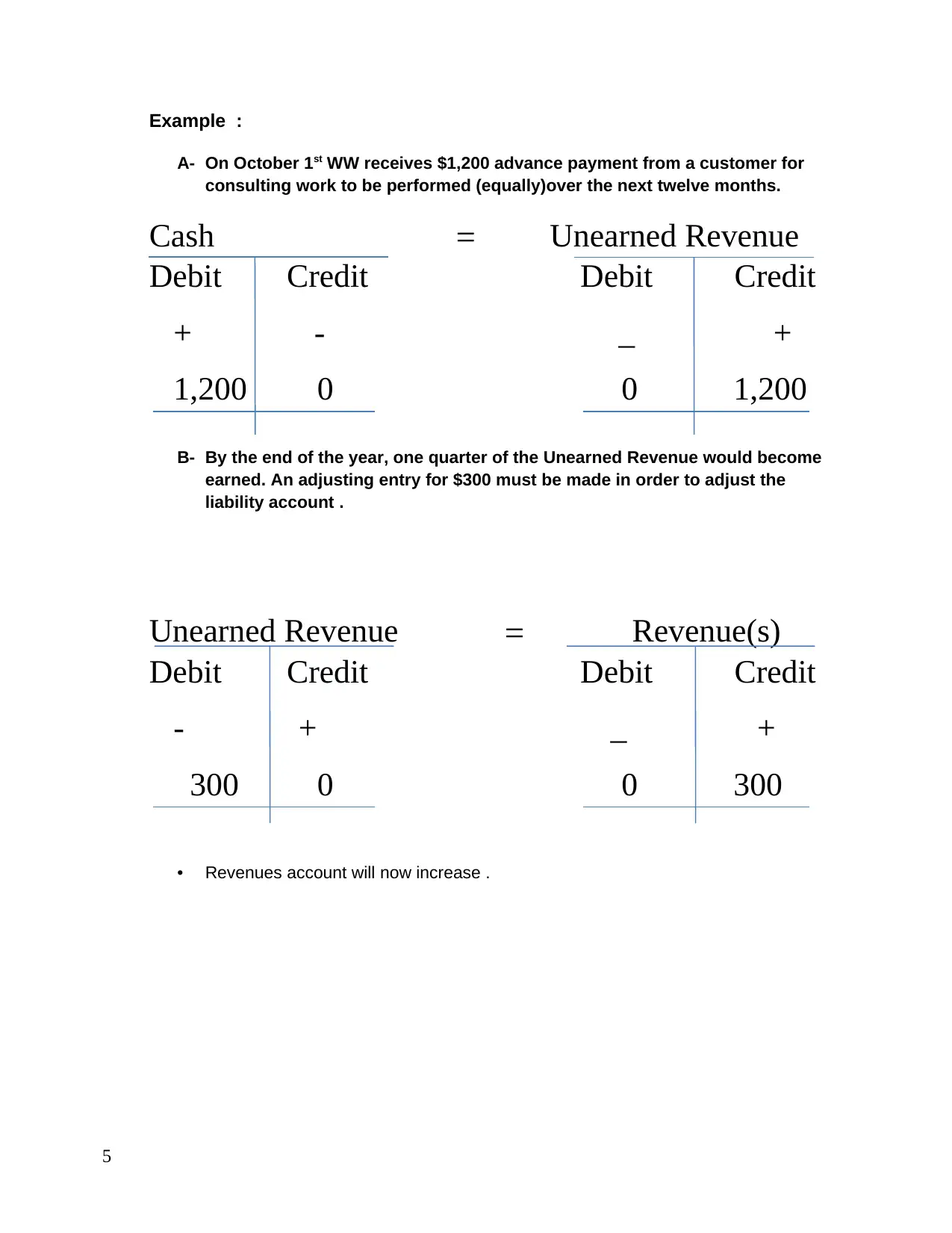
Example :
A- On October 1st WW receives $1,200 advance payment from a customer for
consulting work to be performed (equally)over the next twelve months.
Cash = Unearned Revenue
Debit Credit Debit Credit
+ - _ +
1,200 0 0 1,200
B- By the end of the year, one quarter of the Unearned Revenue would become
earned. An adjusting entry for $300 must be made in order to adjust the
liability account .
Unearned Revenue = Revenue(s)
Debit Credit Debit Credit
- + _ +
300 0 0 300
• Revenues account will now increase .
5
A- On October 1st WW receives $1,200 advance payment from a customer for
consulting work to be performed (equally)over the next twelve months.
Cash = Unearned Revenue
Debit Credit Debit Credit
+ - _ +
1,200 0 0 1,200
B- By the end of the year, one quarter of the Unearned Revenue would become
earned. An adjusting entry for $300 must be made in order to adjust the
liability account .
Unearned Revenue = Revenue(s)
Debit Credit Debit Credit
- + _ +
300 0 0 300
• Revenues account will now increase .
5
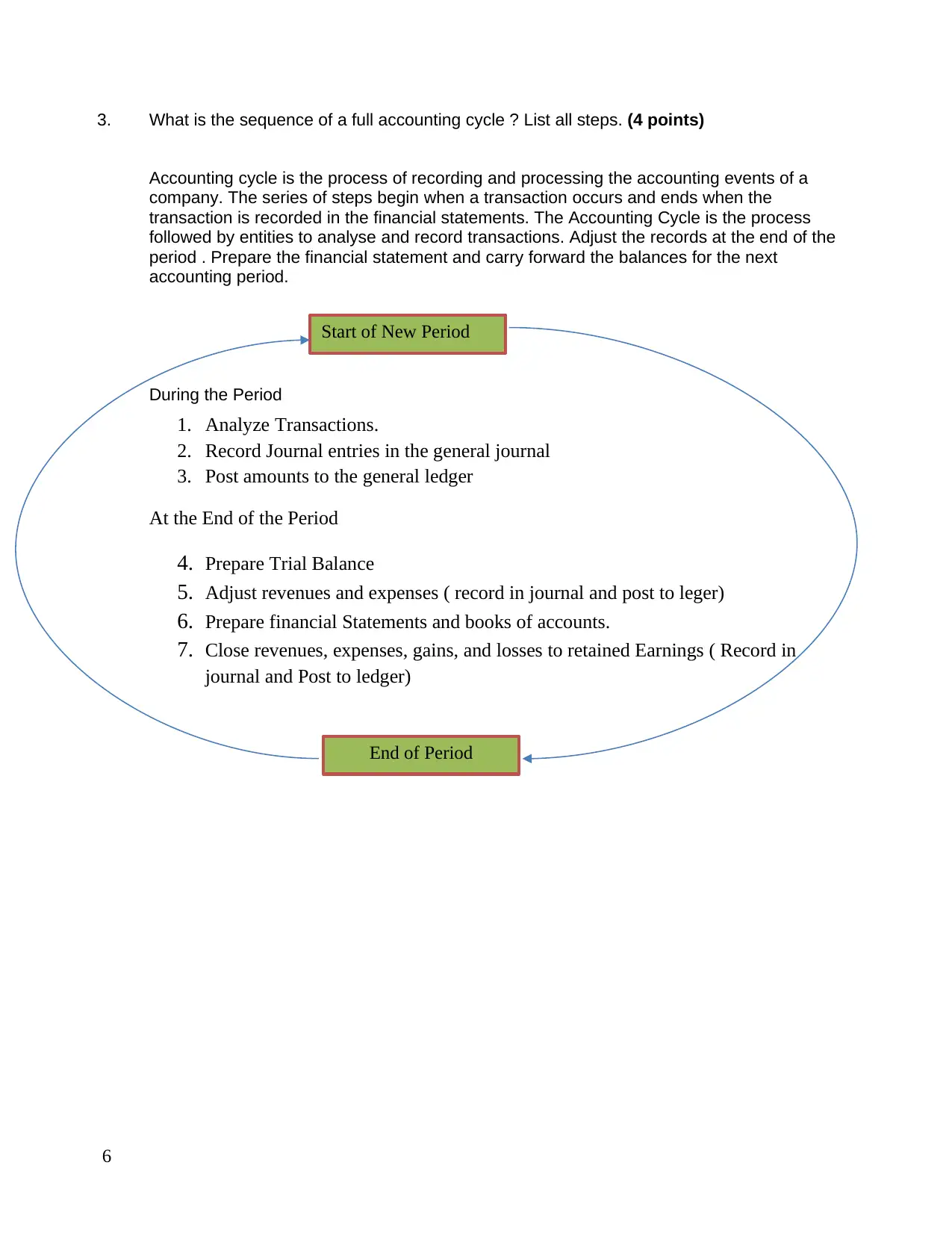
3. What is the sequence of a full accounting cycle ? List all steps. (4 points)
Accounting cycle is the process of recording and processing the accounting events of a
company. The series of steps begin when a transaction occurs and ends when the
transaction is recorded in the financial statements. The Accounting Cycle is the process
followed by entities to analyse and record transactions. Adjust the records at the end of the
period . Prepare the financial statement and carry forward the balances for the next
accounting period.
During the Period
1. Analyze Transactions.
2. Record Journal entries in the general journal
3. Post amounts to the general ledger
At the End of the Period
4. Prepare Trial Balance
5. Adjust revenues and expenses ( record in journal and post to leger)
6. Prepare financial Statements and books of accounts.
7. Close revenues, expenses, gains, and losses to retained Earnings ( Record in
journal and Post to ledger)
6
Start of New Period
End of Period
Accounting cycle is the process of recording and processing the accounting events of a
company. The series of steps begin when a transaction occurs and ends when the
transaction is recorded in the financial statements. The Accounting Cycle is the process
followed by entities to analyse and record transactions. Adjust the records at the end of the
period . Prepare the financial statement and carry forward the balances for the next
accounting period.
During the Period
1. Analyze Transactions.
2. Record Journal entries in the general journal
3. Post amounts to the general ledger
At the End of the Period
4. Prepare Trial Balance
5. Adjust revenues and expenses ( record in journal and post to leger)
6. Prepare financial Statements and books of accounts.
7. Close revenues, expenses, gains, and losses to retained Earnings ( Record in
journal and Post to ledger)
6
Start of New Period
End of Period
⊘ This is a preview!⊘
Do you want full access?
Subscribe today to unlock all pages.

Trusted by 1+ million students worldwide
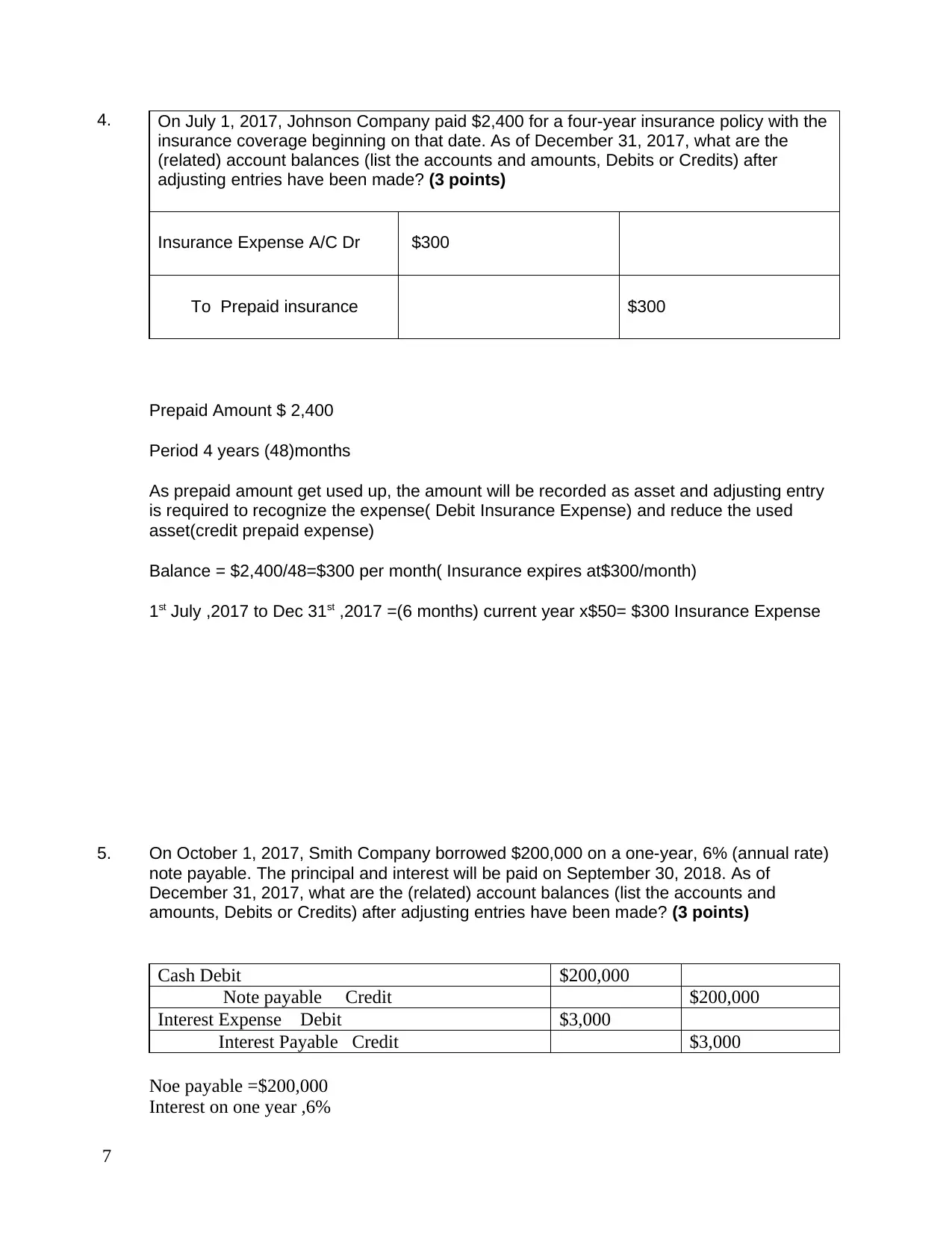
4. On July 1, 2017, Johnson Company paid $2,400 for a four-year insurance policy with the
insurance coverage beginning on that date. As of December 31, 2017, what are the
(related) account balances (list the accounts and amounts, Debits or Credits) after
adjusting entries have been made? (3 points)
Insurance Expense A/C Dr $300
To Prepaid insurance $300
Prepaid Amount $ 2,400
Period 4 years (48)months
As prepaid amount get used up, the amount will be recorded as asset and adjusting entry
is required to recognize the expense( Debit Insurance Expense) and reduce the used
asset(credit prepaid expense)
Balance = $2,400/48=$300 per month( Insurance expires at$300/month)
1st July ,2017 to Dec 31st ,2017 =(6 months) current year x$50= $300 Insurance Expense
5. On October 1, 2017, Smith Company borrowed $200,000 on a one-year, 6% (annual rate)
note payable. The principal and interest will be paid on September 30, 2018. As of
December 31, 2017, what are the (related) account balances (list the accounts and
amounts, Debits or Credits) after adjusting entries have been made? (3 points)
Cash Debit $200,000
Note payable Credit $200,000
Interest Expense Debit $3,000
Interest Payable Credit $3,000
Noe payable =$200,000
Interest on one year ,6%
7
insurance coverage beginning on that date. As of December 31, 2017, what are the
(related) account balances (list the accounts and amounts, Debits or Credits) after
adjusting entries have been made? (3 points)
Insurance Expense A/C Dr $300
To Prepaid insurance $300
Prepaid Amount $ 2,400
Period 4 years (48)months
As prepaid amount get used up, the amount will be recorded as asset and adjusting entry
is required to recognize the expense( Debit Insurance Expense) and reduce the used
asset(credit prepaid expense)
Balance = $2,400/48=$300 per month( Insurance expires at$300/month)
1st July ,2017 to Dec 31st ,2017 =(6 months) current year x$50= $300 Insurance Expense
5. On October 1, 2017, Smith Company borrowed $200,000 on a one-year, 6% (annual rate)
note payable. The principal and interest will be paid on September 30, 2018. As of
December 31, 2017, what are the (related) account balances (list the accounts and
amounts, Debits or Credits) after adjusting entries have been made? (3 points)
Cash Debit $200,000
Note payable Credit $200,000
Interest Expense Debit $3,000
Interest Payable Credit $3,000
Noe payable =$200,000
Interest on one year ,6%
7
Paraphrase This Document
Need a fresh take? Get an instant paraphrase of this document with our AI Paraphraser
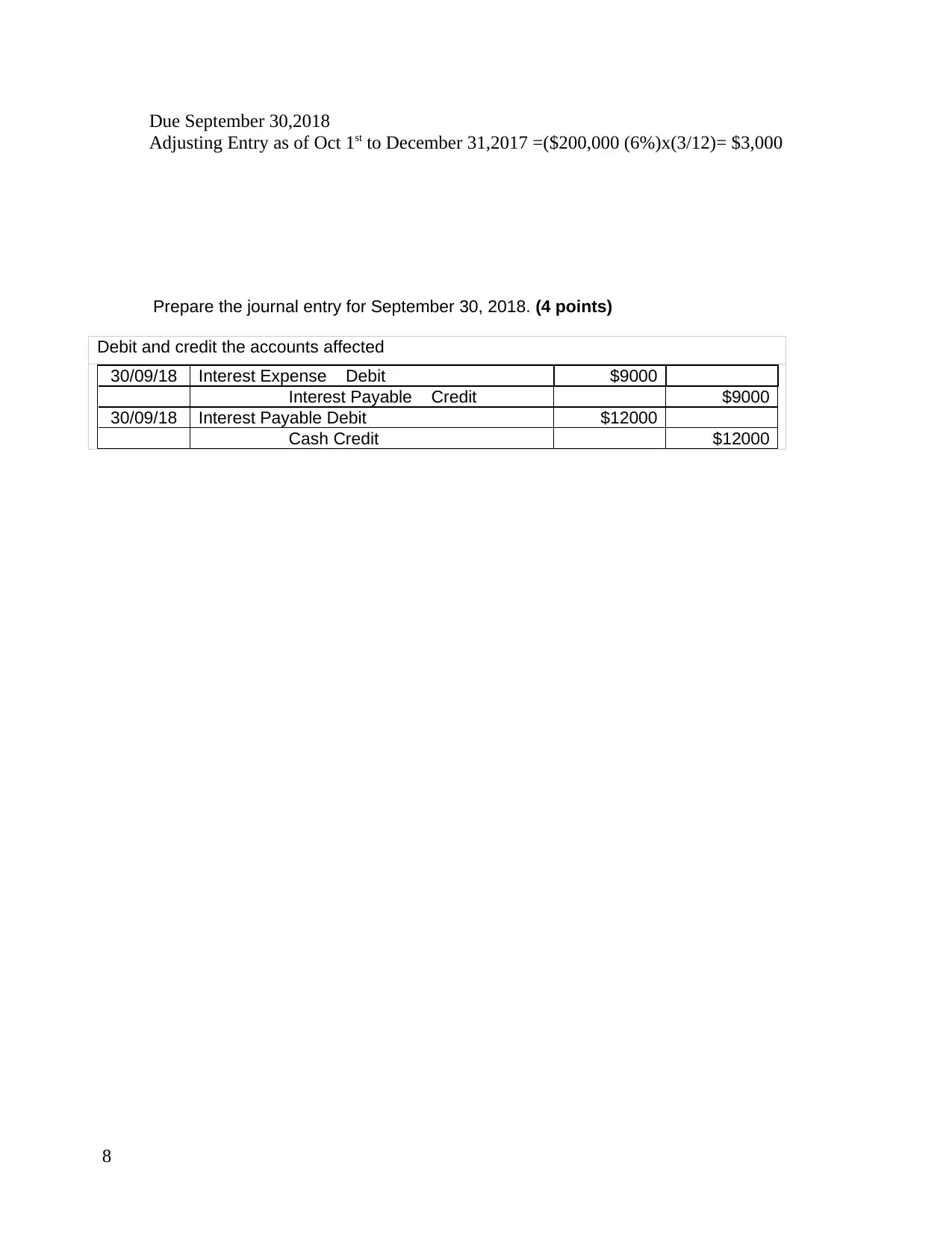
Due September 30,2018
Adjusting Entry as of Oct 1st to December 31,2017 =($200,000 (6%)x(3/12)= $3,000
Prepare the journal entry for September 30, 2018. (4 points)
Debit and credit the accounts affected
30/09/18 Interest Expense Debit $9000
Interest Payable Credit $9000
30/09/18 Interest Payable Debit $12000
Cash Credit $12000
8
Adjusting Entry as of Oct 1st to December 31,2017 =($200,000 (6%)x(3/12)= $3,000
Prepare the journal entry for September 30, 2018. (4 points)
Debit and credit the accounts affected
30/09/18 Interest Expense Debit $9000
Interest Payable Credit $9000
30/09/18 Interest Payable Debit $12000
Cash Credit $12000
8
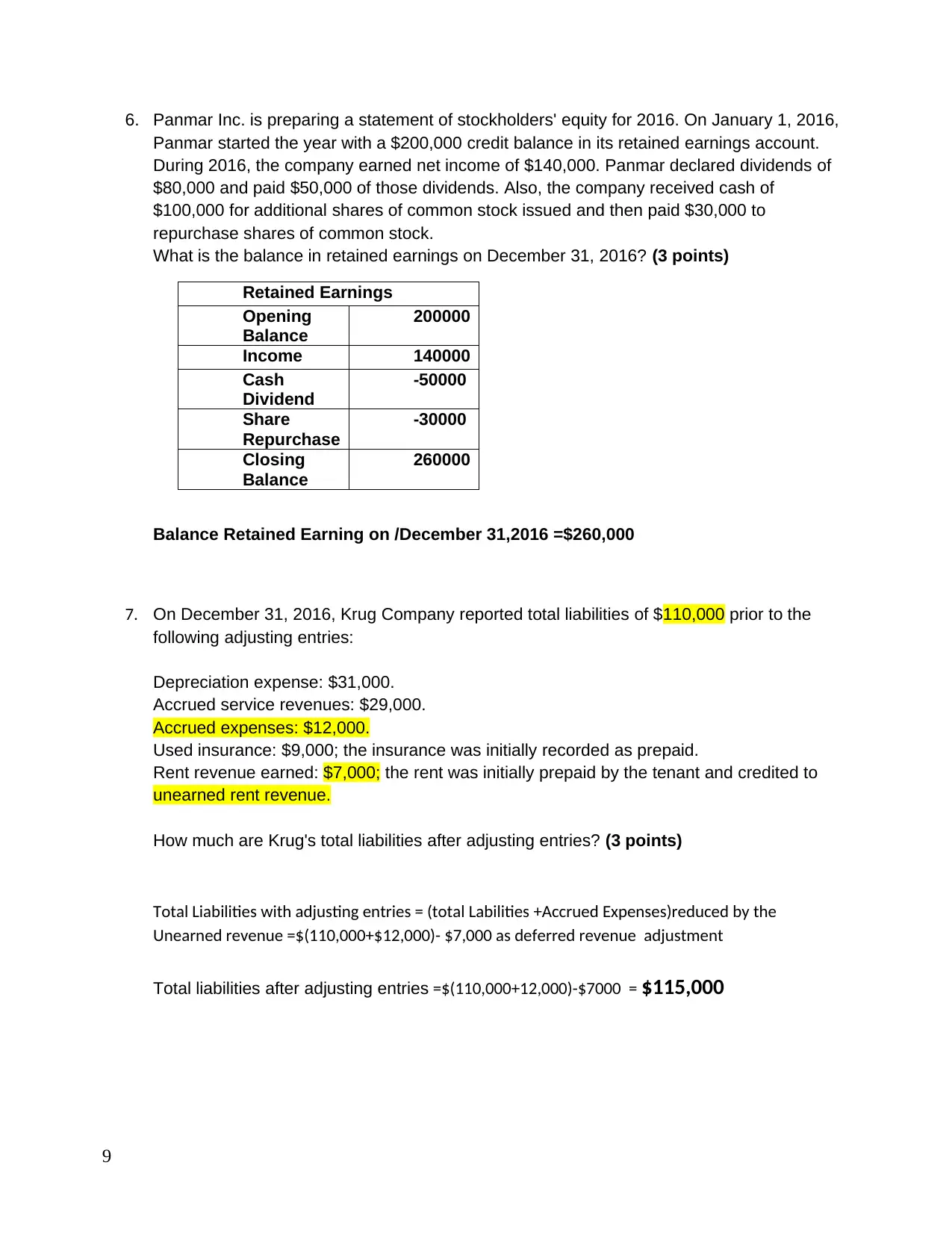
6. Panmar Inc. is preparing a statement of stockholders' equity for 2016. On January 1, 2016,
Panmar started the year with a $200,000 credit balance in its retained earnings account.
During 2016, the company earned net income of $140,000. Panmar declared dividends of
$80,000 and paid $50,000 of those dividends. Also, the company received cash of
$100,000 for additional shares of common stock issued and then paid $30,000 to
repurchase shares of common stock.
What is the balance in retained earnings on December 31, 2016? (3 points)
Balance Retained Earning on /December 31,2016 =$260,000
7. On December 31, 2016, Krug Company reported total liabilities of $110,000 prior to the
following adjusting entries:
Depreciation expense: $31,000.
Accrued service revenues: $29,000.
Accrued expenses: $12,000.
Used insurance: $9,000; the insurance was initially recorded as prepaid.
Rent revenue earned: $7,000; the rent was initially prepaid by the tenant and credited to
unearned rent revenue.
How much are Krug's total liabilities after adjusting entries? (3 points)
Total Liabilities with adjusting entries = (total Labilities +Accrued Expenses)reduced by the
Unearned revenue =$(110,000+$12,000)- $7,000 as deferred revenue adjustment
Total liabilities after adjusting entries =$(110,000+12,000)-$7000 = $115,000
9
Retained Earnings
Opening
Balance
200000
Income 140000
Cash
Dividend
-50000
Share
Repurchase
-30000
Closing
Balance
260000
Panmar started the year with a $200,000 credit balance in its retained earnings account.
During 2016, the company earned net income of $140,000. Panmar declared dividends of
$80,000 and paid $50,000 of those dividends. Also, the company received cash of
$100,000 for additional shares of common stock issued and then paid $30,000 to
repurchase shares of common stock.
What is the balance in retained earnings on December 31, 2016? (3 points)
Balance Retained Earning on /December 31,2016 =$260,000
7. On December 31, 2016, Krug Company reported total liabilities of $110,000 prior to the
following adjusting entries:
Depreciation expense: $31,000.
Accrued service revenues: $29,000.
Accrued expenses: $12,000.
Used insurance: $9,000; the insurance was initially recorded as prepaid.
Rent revenue earned: $7,000; the rent was initially prepaid by the tenant and credited to
unearned rent revenue.
How much are Krug's total liabilities after adjusting entries? (3 points)
Total Liabilities with adjusting entries = (total Labilities +Accrued Expenses)reduced by the
Unearned revenue =$(110,000+$12,000)- $7,000 as deferred revenue adjustment
Total liabilities after adjusting entries =$(110,000+12,000)-$7000 = $115,000
9
Retained Earnings
Opening
Balance
200000
Income 140000
Cash
Dividend
-50000
Share
Repurchase
-30000
Closing
Balance
260000
⊘ This is a preview!⊘
Do you want full access?
Subscribe today to unlock all pages.

Trusted by 1+ million students worldwide
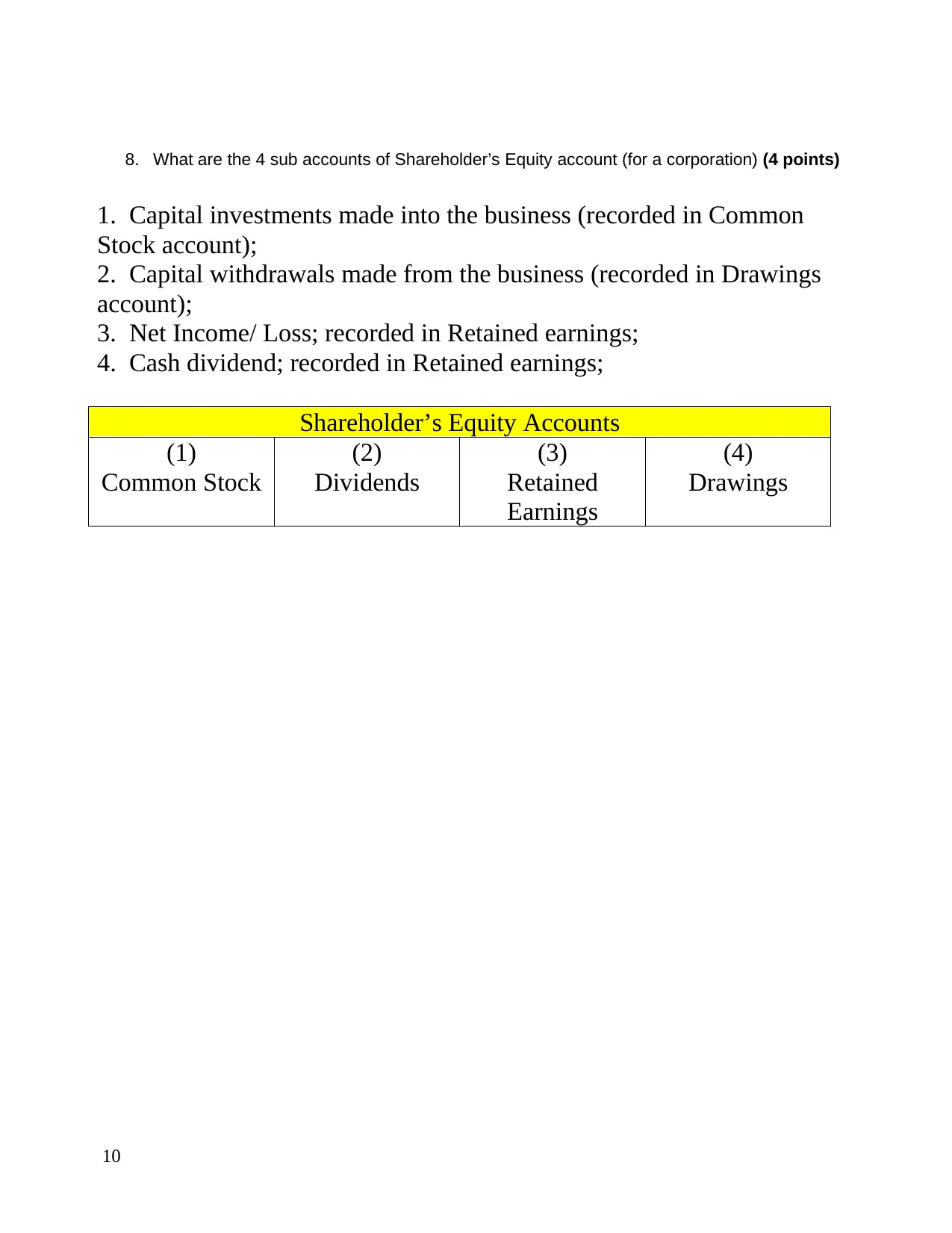
8. What are the 4 sub accounts of Shareholder’s Equity account (for a corporation) (4 points)
1. Capital investments made into the business (recorded in Common
Stock account);
2. Capital withdrawals made from the business (recorded in Drawings
account);
3. Net Income/ Loss; recorded in Retained earnings;
4. Cash dividend; recorded in Retained earnings;
Shareholder’s Equity Accounts
(1)
Common Stock
(2)
Dividends
(3)
Retained
Earnings
(4)
Drawings
10
1. Capital investments made into the business (recorded in Common
Stock account);
2. Capital withdrawals made from the business (recorded in Drawings
account);
3. Net Income/ Loss; recorded in Retained earnings;
4. Cash dividend; recorded in Retained earnings;
Shareholder’s Equity Accounts
(1)
Common Stock
(2)
Dividends
(3)
Retained
Earnings
(4)
Drawings
10
Paraphrase This Document
Need a fresh take? Get an instant paraphrase of this document with our AI Paraphraser
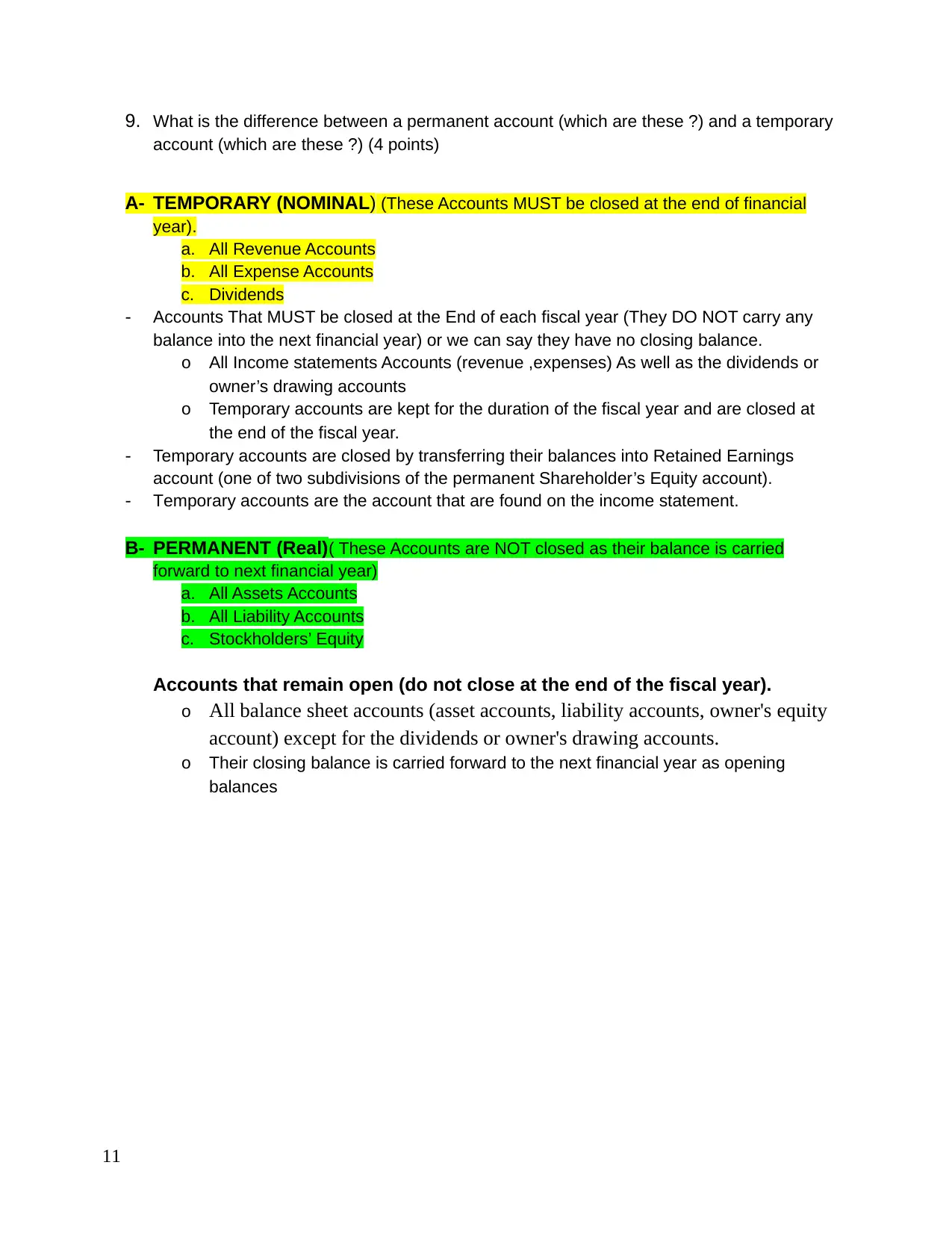
9. What is the difference between a permanent account (which are these ?) and a temporary
account (which are these ?) (4 points)
A- TEMPORARY (NOMINAL) (These Accounts MUST be closed at the end of financial
year).
a. All Revenue Accounts
b. All Expense Accounts
c. Dividends
- Accounts That MUST be closed at the End of each fiscal year (They DO NOT carry any
balance into the next financial year) or we can say they have no closing balance.
o All Income statements Accounts (revenue ,expenses) As well as the dividends or
owner’s drawing accounts
o Temporary accounts are kept for the duration of the fiscal year and are closed at
the end of the fiscal year.
- Temporary accounts are closed by transferring their balances into Retained Earnings
account (one of two subdivisions of the permanent Shareholder’s Equity account).
- Temporary accounts are the account that are found on the income statement.
B- PERMANENT (Real)( These Accounts are NOT closed as their balance is carried
forward to next financial year)
a. All Assets Accounts
b. All Liability Accounts
c. Stockholders’ Equity
Accounts that remain open (do not close at the end of the fiscal year).
o All balance sheet accounts (asset accounts, liability accounts, owner's equity
account) except for the dividends or owner's drawing accounts.
o Their closing balance is carried forward to the next financial year as opening
balances
11
account (which are these ?) (4 points)
A- TEMPORARY (NOMINAL) (These Accounts MUST be closed at the end of financial
year).
a. All Revenue Accounts
b. All Expense Accounts
c. Dividends
- Accounts That MUST be closed at the End of each fiscal year (They DO NOT carry any
balance into the next financial year) or we can say they have no closing balance.
o All Income statements Accounts (revenue ,expenses) As well as the dividends or
owner’s drawing accounts
o Temporary accounts are kept for the duration of the fiscal year and are closed at
the end of the fiscal year.
- Temporary accounts are closed by transferring their balances into Retained Earnings
account (one of two subdivisions of the permanent Shareholder’s Equity account).
- Temporary accounts are the account that are found on the income statement.
B- PERMANENT (Real)( These Accounts are NOT closed as their balance is carried
forward to next financial year)
a. All Assets Accounts
b. All Liability Accounts
c. Stockholders’ Equity
Accounts that remain open (do not close at the end of the fiscal year).
o All balance sheet accounts (asset accounts, liability accounts, owner's equity
account) except for the dividends or owner's drawing accounts.
o Their closing balance is carried forward to the next financial year as opening
balances
11
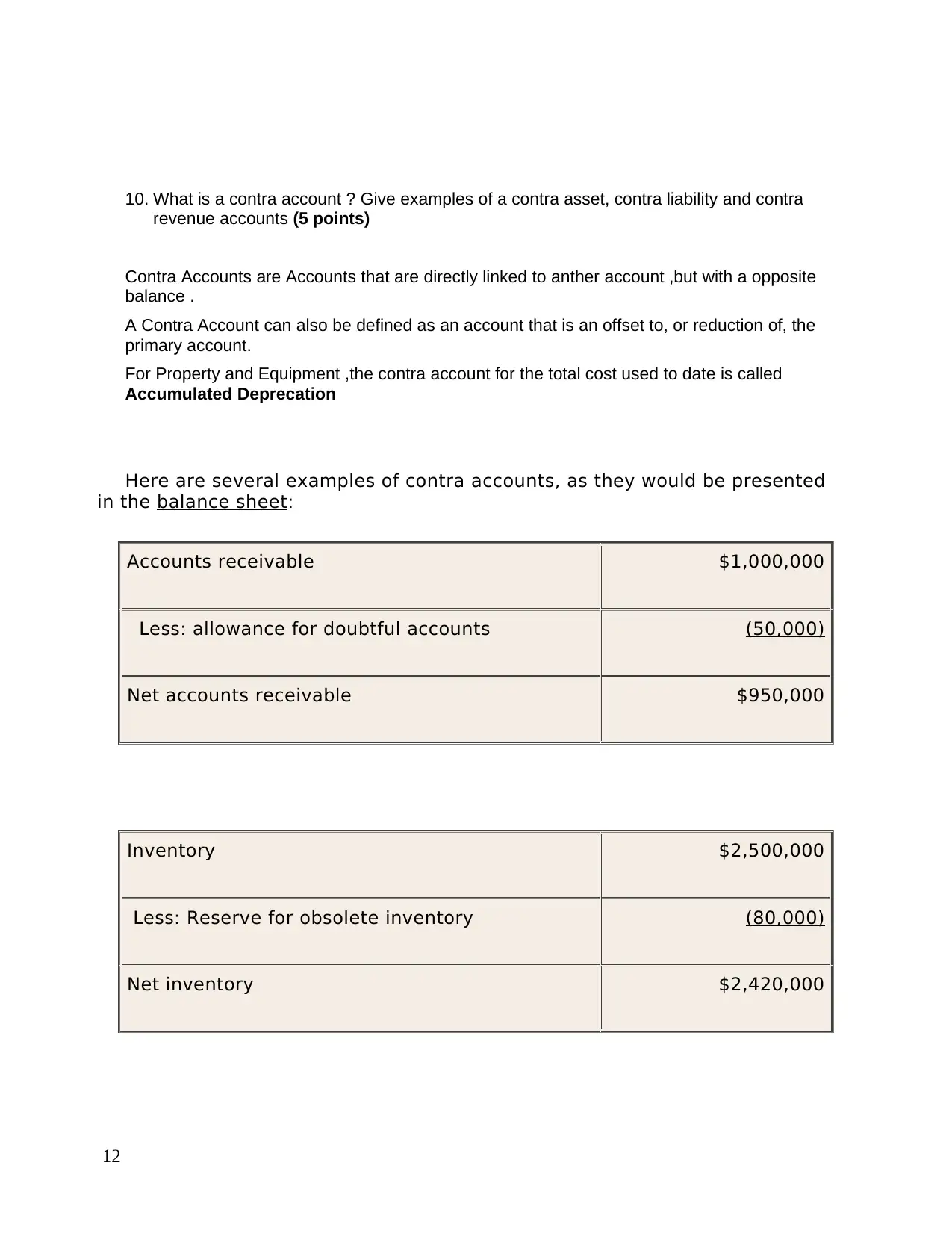
10. What is a contra account ? Give examples of a contra asset, contra liability and contra
revenue accounts (5 points)
Contra Accounts are Accounts that are directly linked to anther account ,but with a opposite
balance .
A Contra Account can also be defined as an account that is an offset to, or reduction of, the
primary account.
For Property and Equipment ,the contra account for the total cost used to date is called
Accumulated Deprecation
Here are several examples of contra accounts, as they would be presented
in the balance sheet:
Accounts receivable $1,000,000
Less: allowance for doubtful accounts (50,000)
Net accounts receivable $950,000
Inventory $2,500,000
Less: Reserve for obsolete inventory (80,000)
Net inventory $2,420,000
12
revenue accounts (5 points)
Contra Accounts are Accounts that are directly linked to anther account ,but with a opposite
balance .
A Contra Account can also be defined as an account that is an offset to, or reduction of, the
primary account.
For Property and Equipment ,the contra account for the total cost used to date is called
Accumulated Deprecation
Here are several examples of contra accounts, as they would be presented
in the balance sheet:
Accounts receivable $1,000,000
Less: allowance for doubtful accounts (50,000)
Net accounts receivable $950,000
Inventory $2,500,000
Less: Reserve for obsolete inventory (80,000)
Net inventory $2,420,000
12
⊘ This is a preview!⊘
Do you want full access?
Subscribe today to unlock all pages.

Trusted by 1+ million students worldwide
1 out of 31
Related Documents
Your All-in-One AI-Powered Toolkit for Academic Success.
+13062052269
info@desklib.com
Available 24*7 on WhatsApp / Email
![[object Object]](/_next/static/media/star-bottom.7253800d.svg)
Unlock your academic potential
Copyright © 2020–2025 A2Z Services. All Rights Reserved. Developed and managed by ZUCOL.





